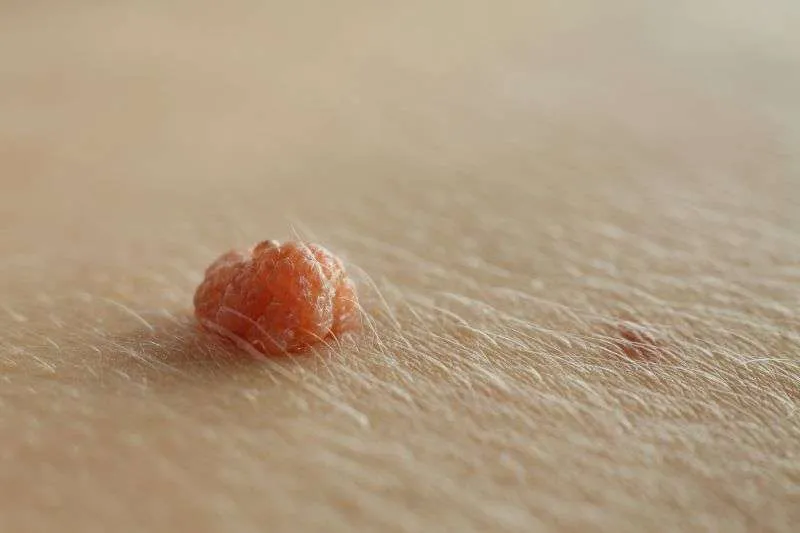In the diverse landscape of our skin, moles and skin tags are common issues. Though often mentioned in the same sense, these two are different in nature, each telling a different story of your skin’s journey. It is easy to spot these little markers, but understanding their nature, origins, and whether or not to consider options like mole removal treatments can be a pathway of discovery. Each mole, and each skin tag needs your understanding and knowledge, but without worry. Let’s explore what is the difference between these two skin issues!
What is Mole?
A mole is a common type of skin growth, often appearing as small, dark brown spots resulting from clusters of pigmented cells. Moles are typically harmless and can develop anywhere on the body. They are different in terms of size, color, in color, and shape, often characterized by a rounded, and slightly raised form.
Moles are usually benign and result from an overproduction of melanocytes, the cells responsible for skin pigmentation. The majority of moles appear during early childhood and adolescence and can change in size and color as one ages.
What is Skin Tag?
A skin tag is a small, benign growth that appears as a soft, hanging piece of skin. Skin tags are typically flesh-colored or slightly darker and often develop in areas where the skin folds or creases, such as the neck, armpits, and groin.
They are caused by friction from skin rubbing against skin or clothing. Skin tags are harmless and painless, although they can become irritated if frequently rubbed or twisted. They consist of loose collagen fibers and blood vessels surrounded by skin and are common in both men and women as they age.
Mole and Skin Tag: Know the Difference
Appearance and Texture
Moles
Moles are typically dark, round, and either flat or slightly raised. They’re often uniform in color and characterized by smooth texture and clear, defined borders. This distinct appearance results from the cluster of melanocytes, or pigment-producing cells.
Skin Tags
Contrarily, skin tags are small, soft, flesh-colored growths that dangle from the skin’s surface. They have a wrinkled texture and are often found in areas of the body where the skin creases, connected by a thin stalk.
Causes and Development
Moles
The emergence of moles is mainly due to the concentration of melanocytes, making them common from childhood. Factors like sun exposure and hormonal changes can influence their size, color, and number as individuals age.
Skin Tags
Skin tags, however, develop due to friction between skin or clothing, commonly found in skin folds. They are often associated with conditions like obesity and are more prevalent among older adults.
Potential for Cancer
Moles
Moles carry a slight risk of developing into melanoma, necessitating regular checks for changes in their appearance. The evolution in size, color, or shape can be an indication of an underlying issue, requiring immediate professional attention.
Skin Tags
Skin tags are entirely benign, with no cancerous potential. They might become irritated due to friction, but don’t pose a significant health threat, making their removal, often, a cosmetic preference.
Removal Procedures
Moles
Removal is sometimes necessary for moles, especially if there’s a suspected cancer risk or for aesthetic concerns. It involves professional medical procedures, including surgical excision, ensuring safety and effectiveness.
Skin Tags
For skin tags, removal is typically simpler, involving snipping, freezing, or similar methods. It can be done at home or by a professional, especially if they become irritated or are considered unsightly.
Common Locations
Moles
Moles are indiscriminate in their location, appearing anywhere on the body, with some present from birth or developing over time. They’re not specifically tied to areas of friction or skin folds.
Skin Tags
Skin tags are more location-specific, often appearing in areas like the neck, armpits, and groin. Their development is directly correlated with friction, making them common in areas where skin rubs against skin or clothing.
Removal and Treatment Options
Professional Treatments for Mole Removal:
Moles can be removed through various professional methods, depending on their size, location, and nature. Surgical excision is common, where the mole is cut out, and the skin stitched up. Other methods include shave excision for raised moles, laser removal, and cryotherapy, where the mole is frozen off. Each procedure is typically quick, with minimal recovery time.
Post-Removal Care and Recovery
After mole removal, it is crucial to follow care instructions to avoid infection and promote healing. This may include keeping the area clean, avoiding sun exposure, and refraining from activities that could irritate the site. Monitoring the site for signs of infection and following up with the dermatologist is essential.
Skin Tags
Professional and At-Home Removal Methods
Skin tags are often removed easily either at home or by a professional. Professionals might use methods like cryotherapy, snipping, or cauterization. At home, over-the-counter solutions or kits can freeze or dry out the skin tag, causing it to fall off. However, it’s vital to ensure that the growth is indeed a skin tag before attempting removal.
Post-Removal Skin Care
The care post skin tag removal involves cleaning the area, applying an antibiotic ointment to prevent infection, and covering it with a bandage for a certain period. Watching for signs of infection and avoiding irritation to the area is important for a swift and smooth recovery.
Prevention and Management
Moles
To mitigate risks associated with moles, especially melanoma, it’s essential to limit sun exposure, especially during peak intensity hours, use sunscreen consistently, wear protective clothing, and avoid tanning beds.
Skin Tags
Maintaining a healthy weight can reduce skin folds (common sites for skin tags). Using talcum powder in prone areas can minimize friction. If skin tags are irritating, avoiding touching or twisting them and seeking professional removal can prevent complications.












